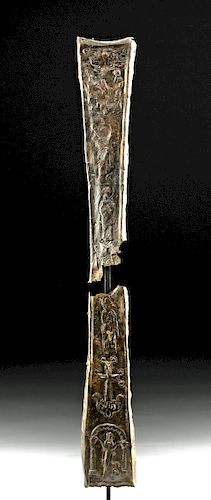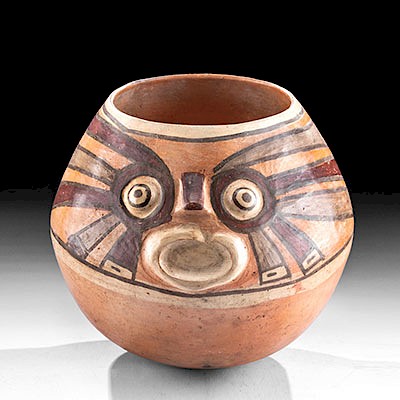9th C. Byzantine Bronze Repousse Cross Panels
Lot 57
About Seller
Artemis Gallery
686 S Taylor Ave, Ste 106
Louisville, CO 80027
United States
Selling antiquities, ancient and ethnographic art online since 1993, Artemis Gallery specializes in Classical Antiquities (Egyptian, Greek, Roman, Near Eastern), Asian, Pre-Columbian, African / Tribal / Oceanographic art. Our extensive inventory includes pottery, stone, metal, wood, glass and textil...Read more
Categories
Estimate:
$12,000 - $18,000
Absentee vs Live bid
Two ways to bid:
- Leave a max absentee bid and the platform will bid on your behalf up to your maximum bid during the live auction.
- Bid live during the auction and your bids will be submitted real-time to the auctioneer.
Bid Increments
| Price | Bid Increment |
|---|---|
| $0 | $25 |
| $300 | $50 |
| $1,000 | $100 |
| $2,000 | $250 |
| $5,000 | $500 |
| $10,000 | $1,000 |
| $20,000 | $2,500 |
| $50,000 | $5,000 |
| $100,000 | $10,000 |
| $200,000 | $20,000 |
About Auction
By Artemis Gallery
Dec 5, 2019
Set Reminder
2019-12-05 10:00:00
2019-12-05 10:00:00
America/New_York
Bidsquare
Bidsquare : Ancient / Ethnographic - Holiday Edition
https://www.bidsquare.com/auctions/artemis-gallery/ancient-ethnographic---holiday-edition-4710
What to give this holiday season? Ancient & Ethnographic Art of course! Our special Holiday auction features hundreds of unique finds from all over the world. Artemis Gallery info@artemisgallery.com
What to give this holiday season? Ancient & Ethnographic Art of course! Our special Holiday auction features hundreds of unique finds from all over the world. Artemis Gallery info@artemisgallery.com
- Lot Description
Near East / Holy Land, Byzantine Empire, ca. 9th to 11th century CE. A pair of bronze repousse panels from the upper and lower arms of a large processional cross. These would have been attached to a wooden frame, with the perforated sides used to attach them. Each features a series of devotional images. At the top of the upper fragment, a figure of the crucified Christ is identified by the inscription "XC". Beneath the arms of the cross stand two nimbate women, one with the incised inscription "MP THY". Below them is a nimbate, draped figure flanked by incised inscriptions "P ? P/POC" and further down is yet another nimbate and draped figure, labeled "PABLO/C". Size of the larger (the upper): 3.5" W x 15.75" H (8.9 cm x 40 cm)
The lower fragment has at its upper edge a nimbate, draped figure of St. Andrew with an incised inscription "ANDP/EAC". He stands over a large cross with rosettes at the corners and foliage below. At the very bottom of the fragment Mary stands with her arms raised under an arch with spirally fluted columns. Her inscription reads, "MHP/THY". The Byzantine Empire was established in the 4th century CE when the Emperor Constantine, also known as Saint Constantine, Christianized the Roman Empire and pronounced the city of Constantinople in Byzantium as the capital. The visual culture of this era demonstrates a synthesis of classical Greek, Roman, and Christian influences. This cross was made at a time when tremendous effort and innovation went into producing art with Christian themes.
Provenance: ex-collection of Janet Zakos, Switzerland, 1970s
All items legal to buy/sell under U.S. Statute covering cultural patrimony Code 2600, CHAPTER 14, and are guaranteed to be as described or your money back.
A Certificate of Authenticity will accompany all winning bids.
We ship worldwide and handle all shipping in-house for your convenience.
#145873Both panels are fragments as shown, displayed together. Slight bending to edges and a few tiny tears/fissures in the surfaces of both, notably the lower part of the upper panel. The backs of both the lower and upper part have been repaired. Remaining motifs are all well preserved and clear with a rich, dark patina.Condition
- Shipping Info
-
All shipping is handled in-house for your convenience. Your invoice from Artemis Gallery will include shipping calculation instructions. If in doubt, please inquire BEFORE bidding for estimated shipping costs for individual items.
-
- Buyer's Premium



 EUR
EUR CAD
CAD AUD
AUD GBP
GBP MXN
MXN HKD
HKD CNY
CNY MYR
MYR SEK
SEK SGD
SGD CHF
CHF THB
THB
















